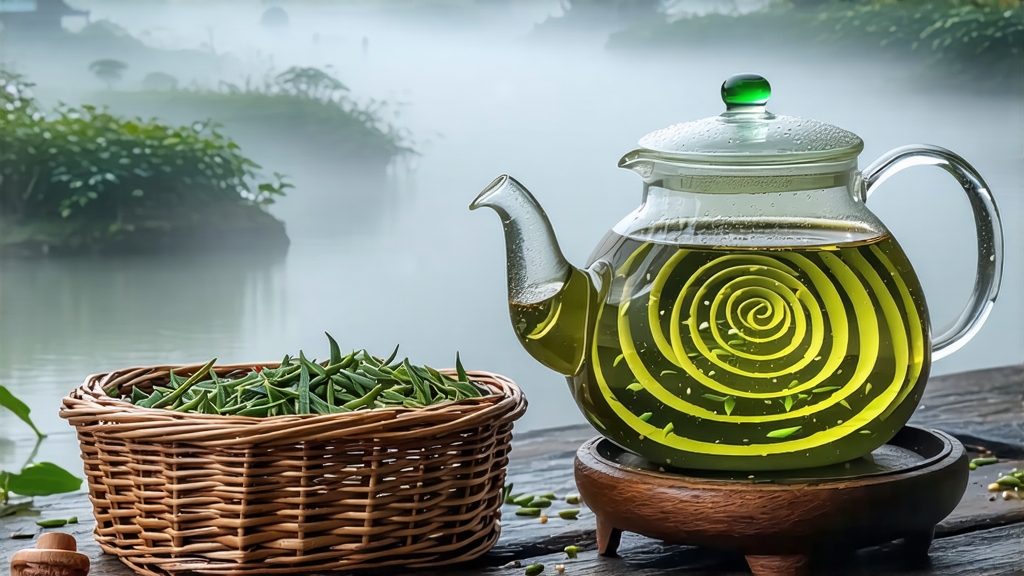
Among the pantheon of Chinese green teas, few names evoke as much poetry and precision as Biluochun. Literally “Green Snail Spring,” the tea is prized for its tiny, tightly rolled spirals that resemble baby snails and for the intoxicating floral aroma that escapes the moment hot water kisses the leaf. To the uninitiated, it may appear almost whimsical—how can so small a curl contain centuries of dynastic lore, maritime trade routes, and the subtle terroir of a lake wrapped in morning mist? Yet from the first sip, Biluochun reveals itself as a masterclass in Chinese refinement: delicate, layered, and insistently fragrant.
Historical Roots: From Island Offering to Imperial Tribute
The story begins on Dongting Mountain, actually two islands—East and West—anchored in vast Lake Tai near Suzhou, Jiangsu province. During the late Tang dynasty (ninth century), monks and hermits already cultivated wild tea shrubs scattered among peach, plum, and apricot trees. The fruit blossoms lent their perfume to the young leaves, an accidental aromatization that later became the tea’s signature. By the Song era, local gazetteers record “Xia Sha Ren Xiang” (literally “scaring-the-human fragrance”), an early name suggesting how startlingly fragrant the tea was. When the Kangxi Emperor visited Suzhou in 1699, court scribes say he was captivated by this “green snail” shape and immediately proclaimed it an annual tribute tea. The imperial endorsement fixed the name Biluochun in the national imagination and elevated tiny Dongting Mountain to celebrity status among tea-growing regions.
Micro-Terroir: Lake Tai’s Mist and Fruit Canopy
Dongting Mountain is not high—its peaks barely exceed 300 m—but it enjoys a rare lacustrine climate. Lake Tai acts as a giant heat reservoir, moderating temperature and bathing the slopes in evaporative mist that filters sunlight into a soft, diffused glow. The humidity encourages slow, tender growth while the constant fog limits photosynthesis, boosting amino acids—especially L-theanine—responsible for sweetness and umami. Unlike the neat hedgerows of Japanese gardens, Biluochun bushes are interplanted with fruit trees: peach, plum, loquat, and bayberry. In early spring, millions of blossoms open simultaneously, and their nectar volatiles settle on the tea buds, creating an olfactory backdrop impossible to replicate elsewhere. Chinese growers call this “biological aromatization,” a natural terroir more nuanced than any artificial scenting.
Cultivars and Grades: Seven Springs in One Name
Although “Biluochun” is geographically protected, the market offers several grades distinguished by pluck standard, harvest date, and cultivar. The pinnacle is “Tou Cai” (first pick, two leaves and a bud) gathered before Qingming festival around 5 April. Such lots may contain 70,000 buds per 500 g and command prices higher than silver. Second is “Yu Qian” (before the Grain Rain, 20 April), still tender but slightly larger. Later flushes become “Cha Shu” or “Da Cha,” stronger and more astringent. Local clones such as “Dongting Qunti” (seed-grown indigenous bushes) remain the gold standard for fragrance, whereas high-yield cultivars like “Fuding Dabaicha” are sometimes grafted in to boost volume. Connoisseurs look for the tiny white tips—downy hairs that catch the light like frost—an indicator of meticulous hand selection.
Crafting the Spiral: A Dance of Heat and Fingers
Biluochun is the earliest green tea processed each year in China, and its manufacture unfolds like choreography across a single day. Picking starts at dawn when the dew still guards the bud from oxidation. Leaves are deposited in shallow bamboo baskets to prevent bruising and transported within two hours to the village workshop. The first step is “sha qing” (kill-green), traditionally in a slanted iron wok heated to 180 °C. With bare hands, the master tosses 250 g of leaves against the scorching metal for three to four minutes, relying on tactile feedback to judge when the enzymes are neutralized. Temperature is then lowered to 70 °C and the shaping phase begins. Using a technique known as “tuan rou,” the maker rolls the semi-brit